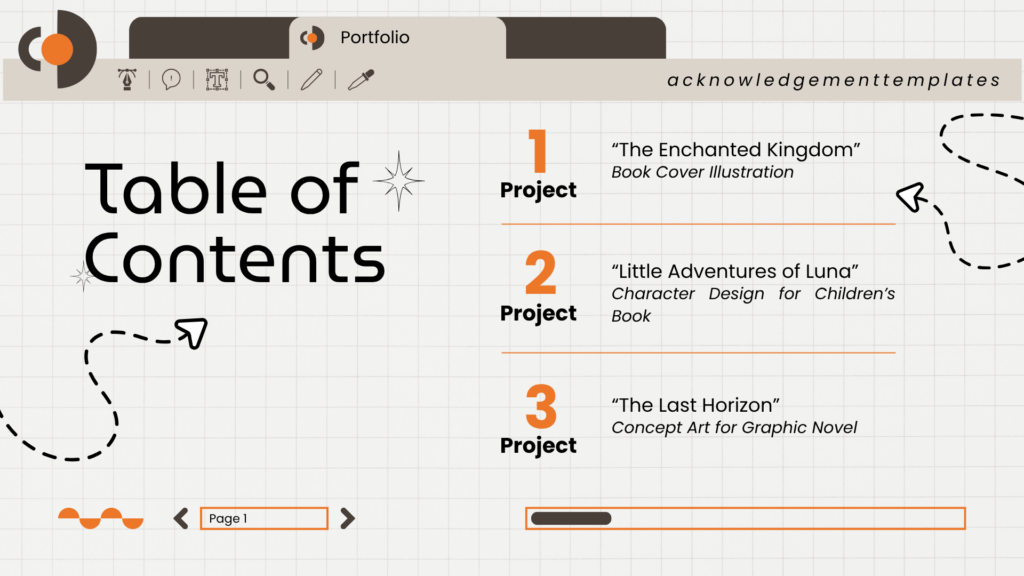
Portfolio Table of Contents sounds a bit formal and boring, right? But imagine opening a portfolio with no table of contents and feeling like you’ve just stumbled into a maze with no exit signs. For educators and students alike, a well-crafted table of contents is like a friendly tour guide that says, “Don’t worry, I’ve got you covered! ”It makes navigating a portfolio smooth and stress-free. Plus, it sets the tone for what’s to come no more guessing games or frantic scrolling.
Why a Portfolio Table Matters
Whether you’re a teacher assembling your showcase or a student presenting your best work, the portfolio table of contents is your portfolio’s roadmap. It helps viewers find what they need quickly, highlights key sections, and shows off your organizational skills. Especially in this era of Flexible Online Learning for All where digital portfolios are more common than ever, having a clear table of contents is a must-have.
What to Include in Your Portfolio Table of Contents
Creating a table of contents isn’t just about listing page numbers; it’s about strategically organizing your content so it tells a story. Here are the essential elements you should include:
1. Introduction or Personal Statement
Start with a brief intro or personal statement. This sets the tone and gives the reader a quick insight into who you are and what your portfolio represents.
2. Educational Background
Include a section for your academic achievements or relevant coursework. For students, this could highlight key classes or certifications; for educators, it might showcase degrees or professional development.
3. Skills and Competencies
List your core skills relevant to your field or learning goals. This section helps viewers quickly understand your strengths.
4. Projects or Assignments
This is the heart of your portfolio. Break down projects or assignments into separate entries, especially if you’re showcasing diverse work. Use descriptive titles so readers know what to expect.
5. Reflections and Self-Assessments
Include your thoughts on what you learned from each project or experience. This adds depth and shows critical thinking.
6. Awards and Recognitions
Don’t be shy to add any honors or awards you’ve earned. This section boosts credibility and pride.
7. Additional Activities or Extracurriculars
Highlight relevant extracurricular activities, volunteer work, or clubs that complement your learning or teaching experience.
8. References or Recommendations
If you have letters of recommendation or testimonials, make sure they have a dedicated spot in your table of contents.
9. Contact Information
Always include how viewers can reach you. This is essential for networking and future opportunities.
10. Appendix or Supporting Documents
If you have extra materials like certificates, transcripts, or detailed reports, list them here so your portfolio stays tidy.
Tips for Crafting Your Portfolio Table of Contents

- Be Clear and Concise: Use simple headings that are easy to understand.
- Use Consistent Formatting: This helps keep everything neat and professional.
- Add Page Numbers or Links: Especially for digital portfolios, clickable links improve usability.
- Keep it updated: Your portfolio will grow, so revisit your table of contents regularly.
- Tailor It to Your Audience: Include sections that your teacher, employer, or admissions committee will value most.
The Impact of a Well-Designed Portfolio Table of Contents
A thoughtfully crafted Portfolio Table of contents doesn’t just organize; it tells a story. It guides the viewer through your learning journey, showcasing growth, skills, and achievements in a way that’s easy to follow and enjoyable. This is crucial in today’s world, where flexible online learning for all means portfolios are often viewed remotely and attention spans can be short.
Conclusion
Your portfolio table of contents is more than just a list; it’s the gateway to your hard work and progress. Including these essential elements ensures your portfolio isn’t just a collection of documents but a well-organized narrative that speaks for you.
Advice: Don’t wait until your portfolio is packed to start designing your table of contents. Plan it from the beginning, keep it clear and updated, and watch how it transforms the way others experience your work!

I’m Ethan Richards, the guy running the show at “Acknowledgment Templates.” I’ve been playing with expressions and formats to make acknowledgment writing a whole lot of fun. Over at Acknowledgment Templates, we’re here to make your acknowledgment section incredible. Let’s add some professionalism and gratitude to your project together!



